
Stuffed Monkey Bread Skillet
This stuffed monkey bread skillet is made using a fluffy brioche dough rolled around buttery, brown sugar cinnamon filling and then rolled in cinnamon sugar. Topped with none other than a cream cheese frosting, the perfect alternative to a cinnamon roll if you’re feeling fancy.
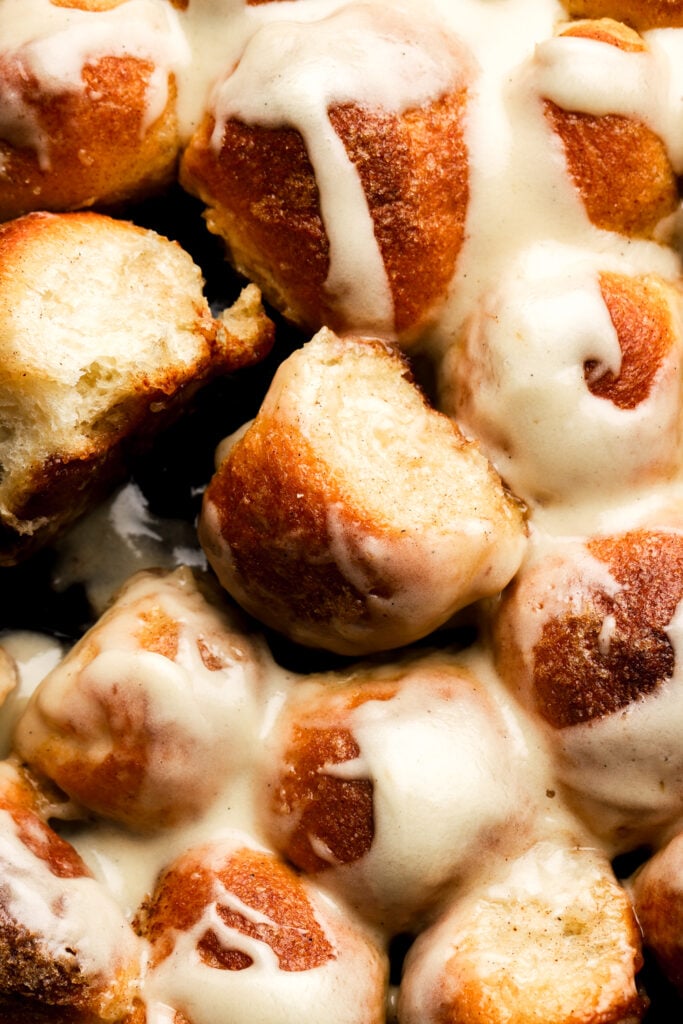
Why you’ll love my monkey bread
- Making dough can be intimidating and it sounds a lot more complicated than it actually is. But I’ve really simplified it into steps that are EASY to follow.
- Truly there’s nothing like a fresh homemade cinnamon roll. So now imagine a bite sized finger food version that’s stuffed with the filling!
- I won’t say these are less effort than a traditional cinnamon roll but they do make more so you can serve a larger crowd and I will say they are more addicting because they’re bite size and so gooey.
For more cinnamon roll recipes check out my traditional Homemade Cinnamon Rolls, Pumpkin Cinnamon Rolls, Gingerbread Cinnamon Rolls, Apple Butter Cinnamon Rolls, and S’mores Cinnamon Rolls.
If it’s autumn and you have pumpkin on your mind (and taste buds lol) you can also try my Pumpkin Streusel Muffins, Pumpkin Bread With Cream Cheese Icing, Pumpkin Cheesecake Cupcakes and Upside Down Pecan Pumpkin Cake.
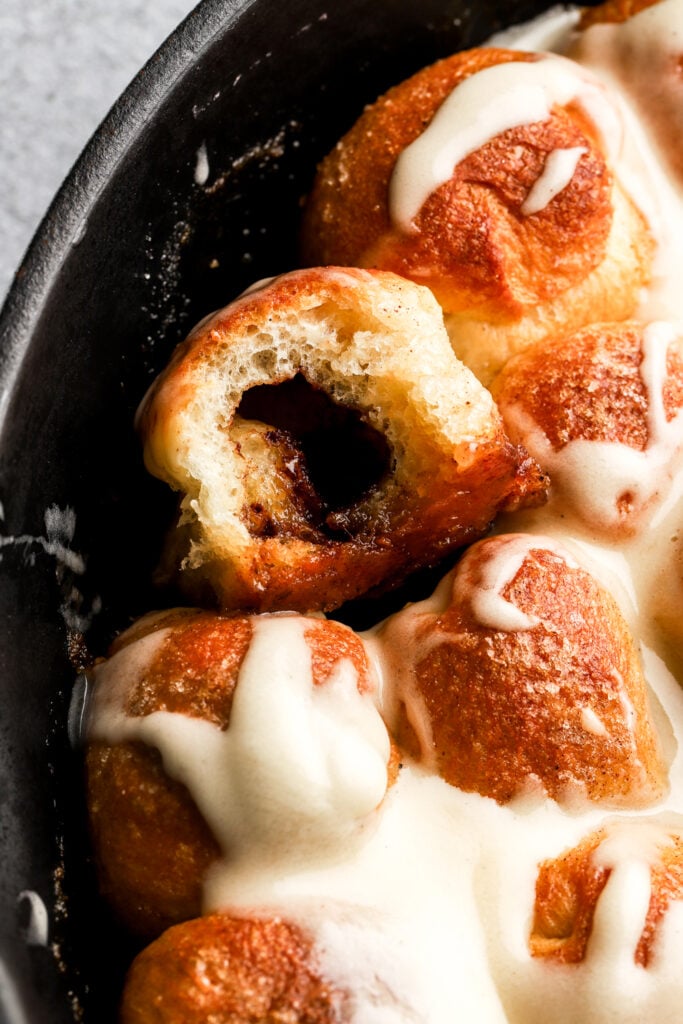
Ingredients:
- Flour: I’ve made this dough with both bread flour and all purpose flour with no noticeable difference in the dough.
- I HIGHLY recommend using a digital scale, as flour is so often over measured.
- Yeast: I used one package of active dry yeast. That can also be subbed with instant yeast, just skip the activation step and mix it in with the rest of the ingredients. I still do both proofs with instant yeast, it’s just usually much quicker (about half the time).
- If you store your yeast in a jar instead of individual packages you can use a scant tablespoon of yeast. Also make sure to store the yeast in the fridge if it’s an open jar.
- Sugar: I used granulated sugar for the dough and rolling and light brown sugar for the filling and I used powdered sugar to make the cream cheese icing.
- Water: this may seem weird since most people make brioche with milk. I have tested this SO MANY times both with milk and water and I found that water makes a much softer dough.
- Butter: I like to use salted butter but you can also use unsalted butter as well, just add an extra pinch of salt. Dairy free butter also works well.
- Eggs: make sure to use one room temperature large egg.
- Place it in hot water for a few minutes if it’s cold.
- Cinnamon: any ground cinnamon will do.
- Vanilla: I used just a bit of vanilla extract in the dough. I love vanilla beans or vanilla bean paste in icing but I didn’t have any so feel free to add that if you have any.
- Cream Cheese: I always use full-fat cream cheese. Make sure it’s room temperature so it mixes well with the powdered sugar.
Step-By-Step Instructions
Cinnamon Sugar Filling
Step 1: Combine the butter, brown sugar and cinnamon until they’re well combined. Freeze for 15 minutes, while you make the dough.
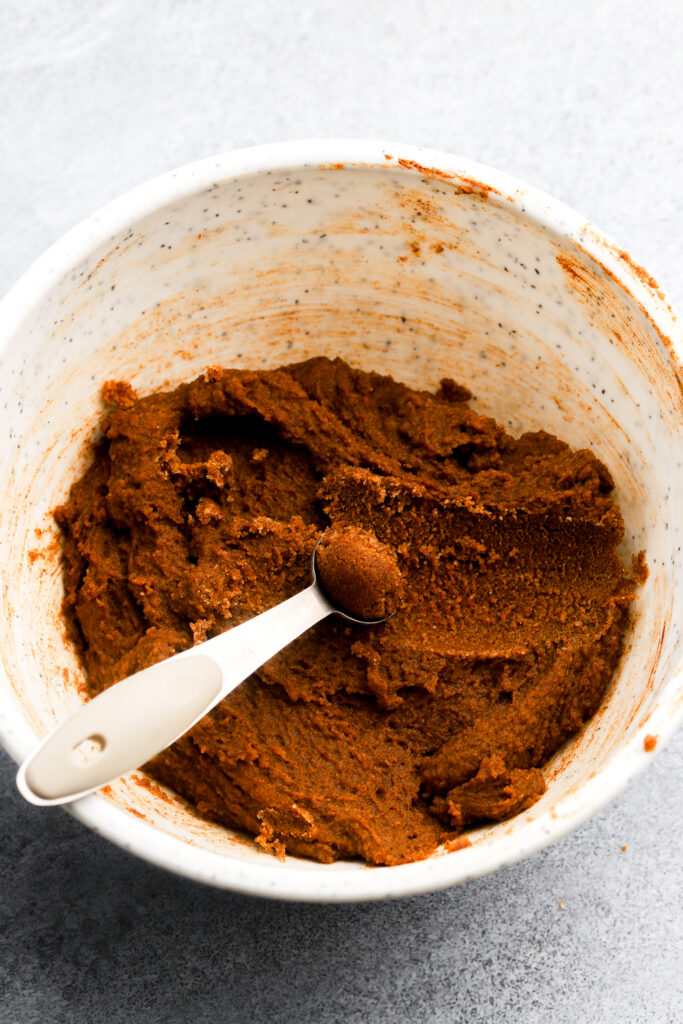
Dough
Step 1: Place the yeast with half of the sugar and the warm water in the bowl of a stand mixer. Mix and allow it to rest for 5-10 minutes, until the yeast starts to foam (SKIP IF USING INSTANT YEAST).
Step 2: Add the rest of the sugar, melted butter, egg and pumpkin puree, mixing until combined.
Step 3: Add the flour, salt and spices and mix until it comes together.
Step 4: Use the hook attachment to knead the dough for about 10 minutes, the dough should be soft but strong enough to stick to itself, not the bowl or your hand.
Step 5: Cover and let it proof for about 90 minutes in a warm environment (COULD BE HALF THIS TIME WITH INSTANT YEAST).


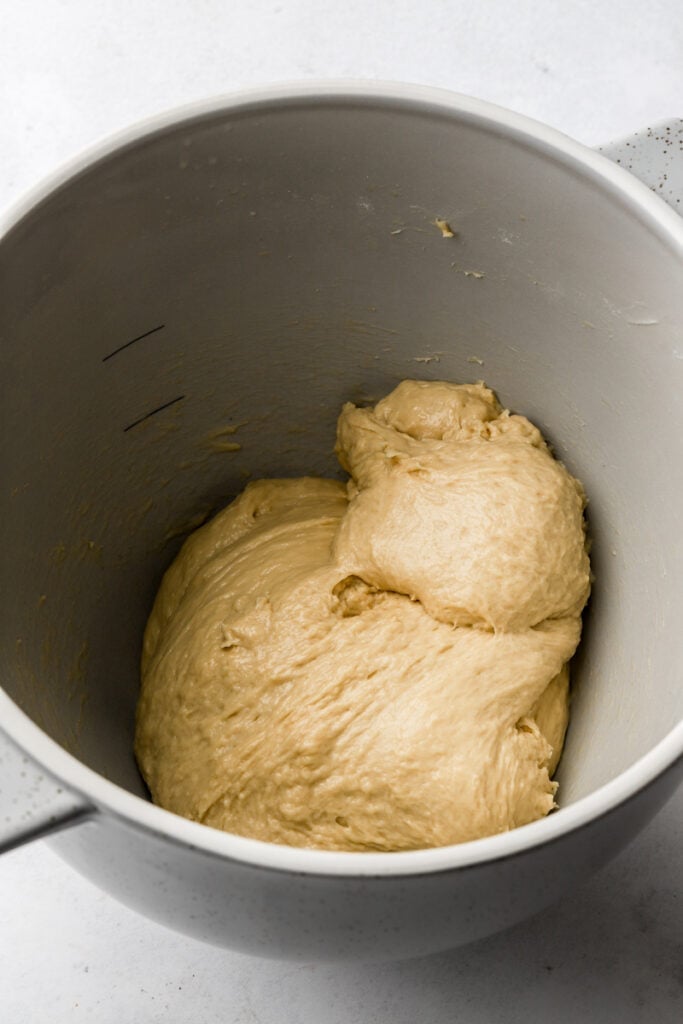
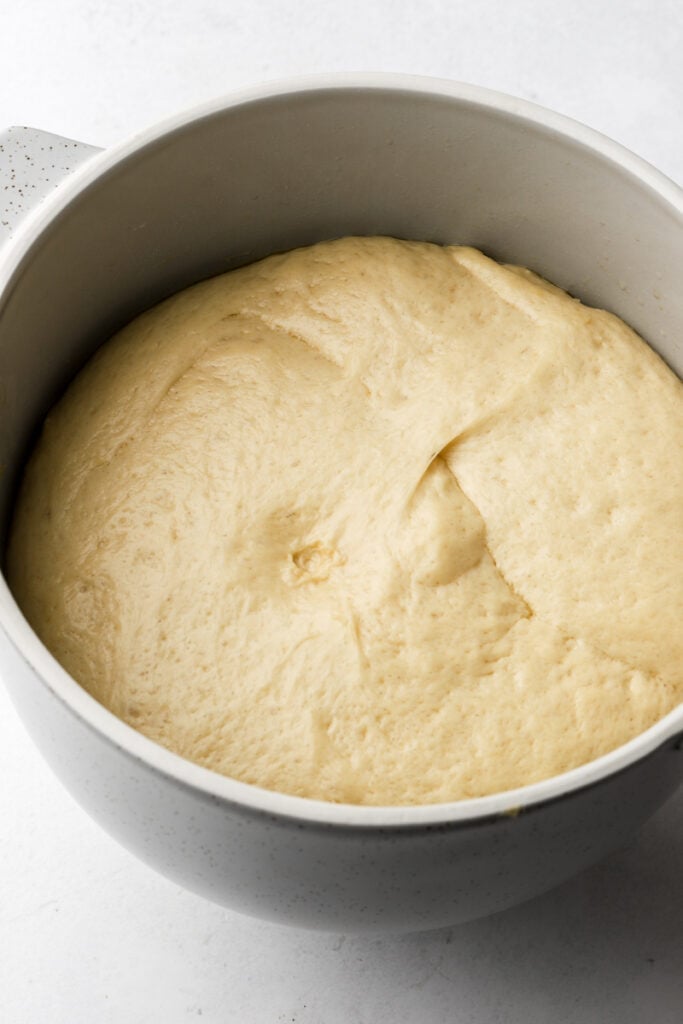

Filling
Step 1: Scoop out little balls of the frozen filling using a 1 tsp measuring spoon and set them on a cookie sheet or large plate.
Step 2: Freeze the filling balls again until they’re ready to be used, at least 30 minutes.

Shape
Step 1: Start by punching down the air and placing the dough onto a floured surface. Gently stretch it out into a rectangle with your hands then use a rolling pin to make it into a 10×12 inch rectangle (doesn’t have to be perfect or exact).
Step 2: Slice the rectangle with a knife or pizza cutter into 6 strips one way and 5 strips the opposite way, so you have 30 2ish-inch squares.
Step 3: Place a ball of the filling on top of each square and then pinch all the edges of the dough together, enclosing the filling. Place it on the counter and hover your hand over it while moving in a circular motion to smooth out the seams (see video).

Step 4: Roll in cinnamon sugar and place them in the prepared pan. Cover and allow them to proof for another 45ish minutes, until they’ve doubled in size.
Step 5: Pour the butter on top of the rolls then bake for about 25ish minutes, until they’re golden brown.
Step 6: Allow to cool for a few minutes before frosting.

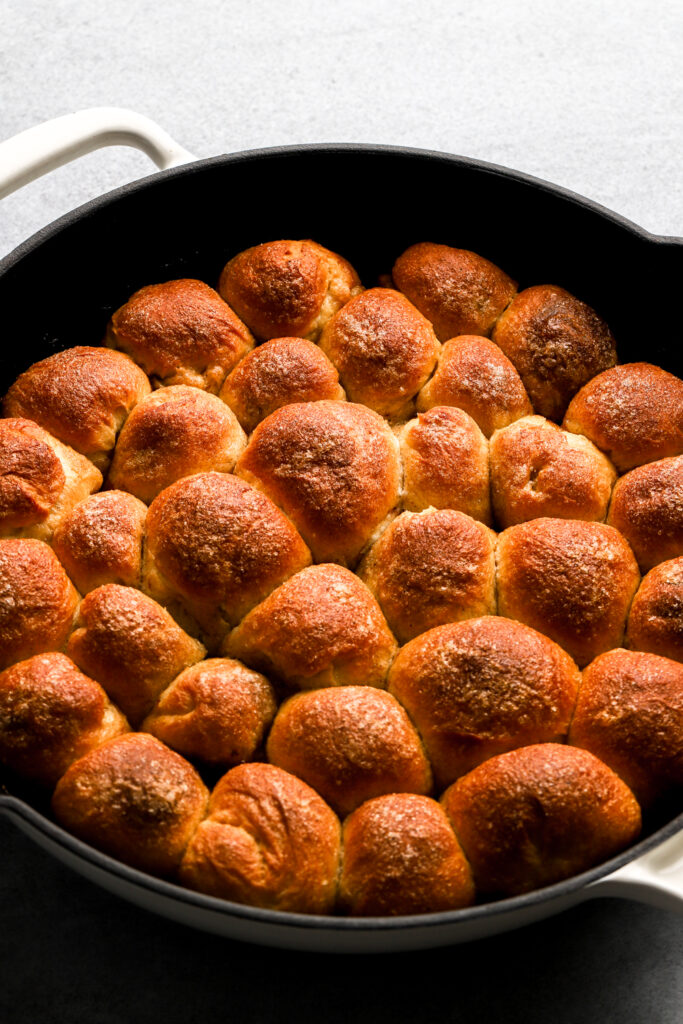
Cream Cheese Icing
Step 1: Combine the softened cream cheese with the powdered sugar, cream, salt and vanilla mixing until they’re well combined and then spread on top of the just slightly cooled rolls.

What kind of yeast to use for brioche dough
I wanted to do a whole separate section on this to explain how to use both active dry yeast and instant yeast in this recipe. I’ve made this recipe many many times with both types and both of them turn out amazing.
The recipe is written using active dry yeast because that’s what most people use. But if you want to substitute it for instant/rapid rise yeast, just skip the activation.
Active Dry Yeast
Active dry yeast needs to be activated. To do this, combine the warm water with the yeast and HALF of the sugar in a large cup. Mix it and let it rest for 10 minutes. The water should develop a thick layer of foam on top (see photo above).
If the yeast mixture doesn’t foam after at least 10-15 minutes, then the water was either too hot and killed the yeast or the yeast has expired. To be safe, make sure the water is lower than 120 °F (50 °C).
After the mixture has foamed, combine it with the rest of the ingredients and proceed to kneading.
Instant Yeast
If using instant yeast, skip activation.
Combine all the wet ingredients with the sugar in the bowl of the stand mixer, then add the flour, yeast and salt on top and mix until it comes together. Proceed the same way with the kneading.

How Long To Knead Brioche Dough
Kneading brioche can take anywhere from 5-15 minutes with a stand mixer or double/triple that by hand.
I like to use my Kitchen aid 5qt stand mixer with a hook attachment on speed 2. You can see in the images below how the dough looks when it first comes together vs. when I’m done kneading. It generally takes me about 10-12 minutes.
There’s a few markers I use to know when the dough is done kneading.
- The dough should form a ball around the hook attachment on the stand mixer and not stick to the sides of the bowl anymore. It may still stick to the bottom of the bowl a little but not all over the sides.
- The dough should also pass the windowpane test. The windowpane test is when you stretch a piece of the dough between your fingers until it’s thin enough to see light through before the dough tears.
If your dough is not passing any of these but is fairly close, that’s ok, just move on after kneading for 10-15 minutes.
If your dough is still really sticky and you can’t even touch it without it sticking to everything, add 2 more tablespoons of flour at a time, until your dough is able to be handled without sticking to your hand.

What Temperature To Proof Dough At?
You want to make sure your dough is proofing at a comfortable temperature. Generally, room temperature is fine but if it’s slightly warmer, you’ll get a much quicker rise.
Yeast dies at around 120F (50C) so make sure the temperature is lower than that. I recommend anywhere between 75F (24C) to 100F (38C).
The dough can also be proofed in the refrigerator. This is called a retarding proof because it really slows down the process. The Benefit of this is that you can just pop the dough in the fridge overnight and the dough will develop a stronger flavor if it proofs for longer.
You can refrigerate the dough overnight for the first proof or the second proof, just bring it back to room temperature before proceeding with the recipe.
How To Know When Dough Is Done Rising/Proofing
Rising and proofing are typically used interchangeably but the initial ‘resting time’ is actually the rising and the second ‘resting time’ is the proofing. The time needed for rising/proofing is dependent on the recipe and the environment.
Typically with instant yeast, you’re “allowed” to skip the first rise and just let the dough relax for just 10 minutes instead before shaping the dough. I prefer to still let it rise. It works both ways but I get a fluffier dough from letting it proof twice.
A general guideline is that the dough should double in size each time. It should also slowly spring back when you press on it, but also leave a small indent.
If the dough springs back quickly, then it needs more time to rise. If it doesn’t spring back at all, it may be over proofed and result in a flat, deflated bread.

What pan to bake the monkey bread in
It is a “monkey bread skillet” so I prefer a cast iron skillet but a metal pan will do as well. Ceramic and glass pans are ok too but they usually heat more unevenly and brown less.
For the 30 small rolls, I use my 13″ round cast iron pan or a 9x13x2 inch pan or one that is just slightly larger than that will work too.
How to make skillet monkey bread overnight
The monkey bread can easily be prepped the night before and baked in the morning. After the dough is rolled and sliced and placed in the prepared pan, cover it tightly with plastic wrap and place it in the fridge or freezer. Refrigerate overnight or freeze for a couple of weeks and then bring to room temperature before baking.
From the fridge, it may take 1-2 hours to bring to room temperature (again, don’t want to overproof so don’t leave it out too long).
From the freezer it may take several hours, feel free to thaw it in the fridge overnight so it’s quicker.
Proceed with normal baking instructions (butter goes in right before baking).

How to store skillet monkey bread
Monkey bread is best served fresh and warm. If they’re not served immediately, it’s best to
reserve the frosting and frost them before serving.
The rolls can stay in an airtight container at room temperature for 1-2 days (unfrosted) and refrigerated for up to a week. When serving, reheat them in the microwave or the oven just until they’re warm and then frost.
If they are frosted and not eaten right away, refrigerate them and reheat them before serving, keeping in mind the frosting will melt and probably look separated but it will still taste good.
I recommend microwaving to reheat them or bake at a low temperature and keep an eye on it. I once placed them back in the oven at 350F after refrigerating overnight with the frosting and the frosting kind of toasted on there LOL it was like crisp on top and not pleasant so now I just use the microwave.

Thanks so much for reading today’s post, if you have any questions just comment down below.
If you make this stuffed monkey bread skillet, I would love it if you left a star rating for it in the recipe card.
As always, have a blessed day and happy baking!
Love, B

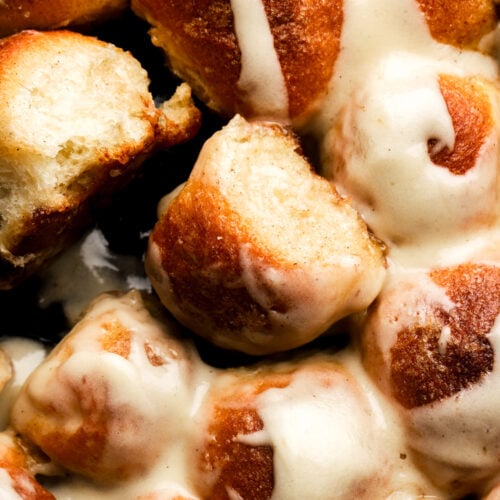
These are delicious! They’re like little bite-size cinnamon rolls that are perfect for feeding a crowd and making special breakfasts for people. The dough is super soft and fluffy, and the cinnamon filling kinda just melts into the dough, leaving a gooey, delicious mess, and then with that cream cheese frosting on top… I made the dough, let it rise, filled, and shaped the night before, then let them sit in the fridge overnight. I took them out in the morning, let them come to room temperature, popped in the oven, slathered with frosting, and served! Everybody loved them and ate wayyyy to many 🙂 I did make them in a 13×9 pan, and it worked out wonderfully. My only feedback is that the cinnamon sugar recipe included in the instructions made a lot more than was needed, and it didn’t stick to the dough balls very well anyway. In the end, I sprinkled cinnamon sugar over the balls after pouring the butter over, and it turned out very well. I will definitely make these again and keep them in mind for special breakfasts!